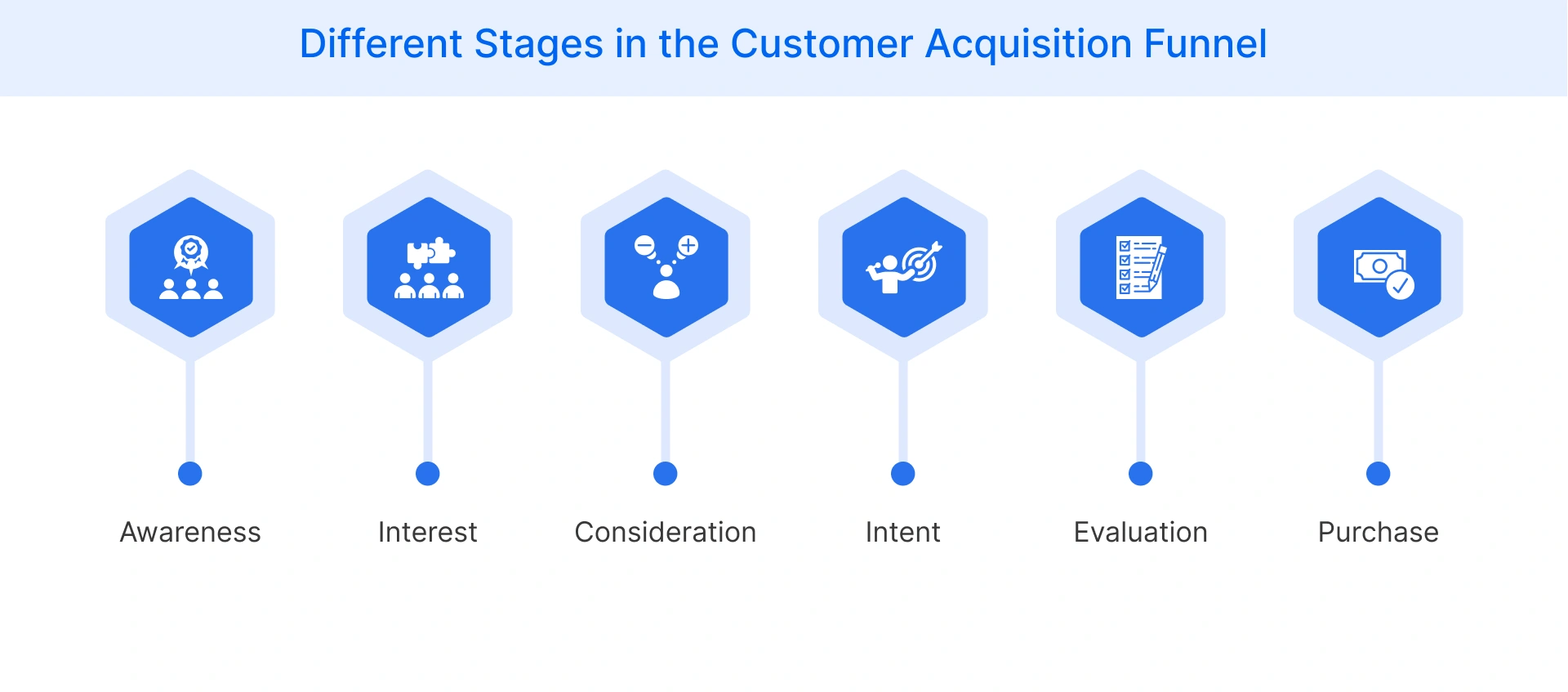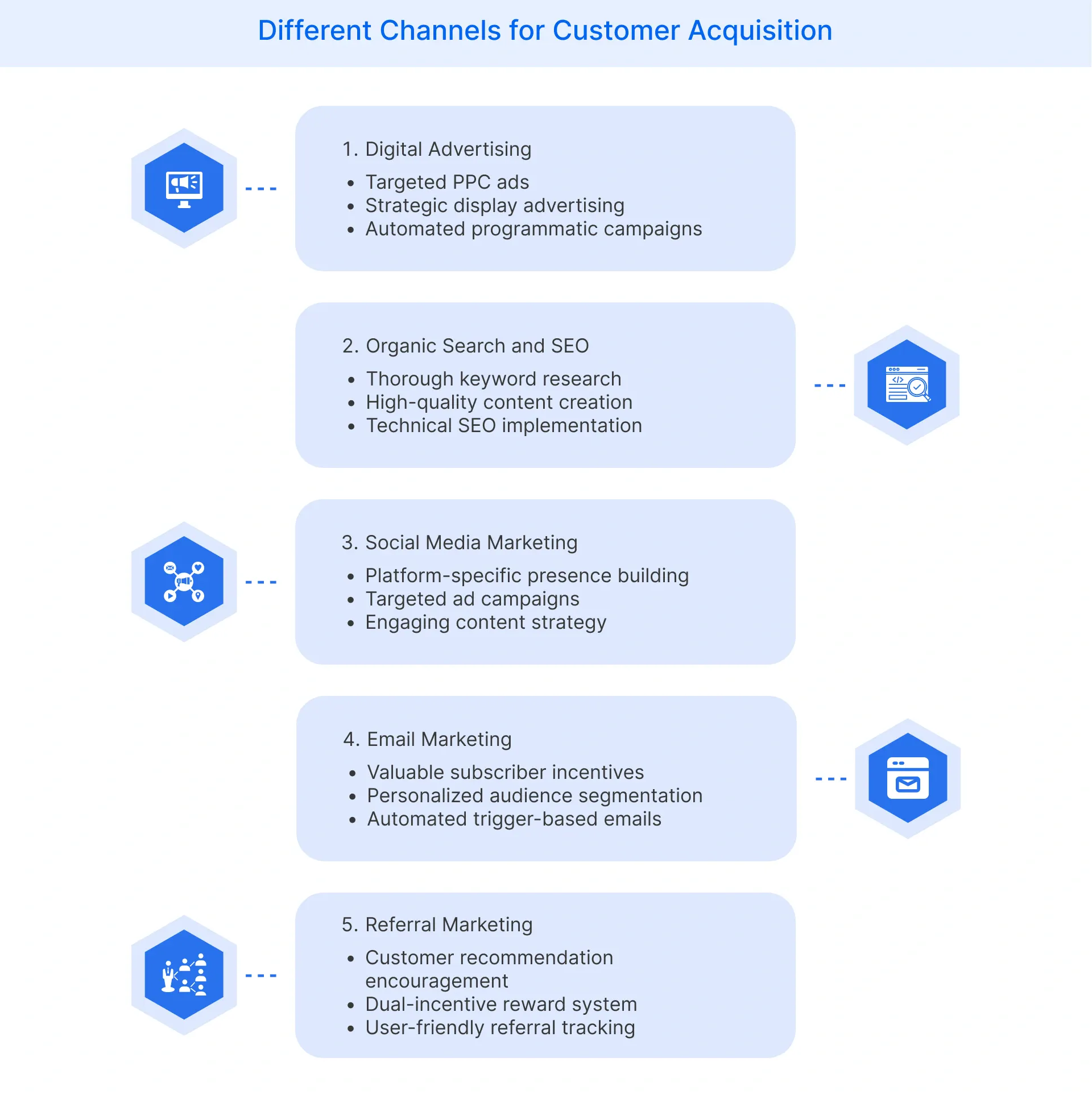Table of Contents
-
What is Customer Acquisition?
-
Why Does Customer Acquisition Matter for Retail and E-commerce?
-
What is the Customer Acquisition Funnel?
-
How Does Customer Acquisition Compare to Customer Retention?
-
What are the Most Effective Channels for Customer Acquisition?
-
How Do You Measure Customer Acquisition Success?
-
Conclusion
What is Customer Acquisition?
Customer acquisition is the process through which businesses target potential buyers to convert interest into long-term customer relationships. It involves targeted efforts such as advertising, promotions, and outreach to persuade prospects to make a purchase.
It acts as a key mechanism that drives the sales pipeline within a competitive landscape. Businesses craft campaigns and offers to capture the interest of potential customers unfamiliar with their brand. For retailers, effective customer acquisition transforms unknown individuals into committed buyers with efficiency and precision.
Distinct from broader marketing, this process emphasizes tangible outcomes by turning interest into completed sales. Businesses align their strategies with the preferences of their target audience, ensuring efforts lead to lasting results.
Why Does Customer Acquisition Matter for Retail and E-commerce?
Customer acquisition plays a pivotal role in the growth and sustainability of retail and e-commerce businesses. By consistently attracting new customers, companies can offset natural customer churn and expand their market presence. This continuous influx of new clients is essential for maintaining a healthy business ecosystem and driving long-term success.
Customer acquisition also serves as a powerful tool for building brand awareness and recognition. As businesses engage in various acquisition strategies, they also increase their visibility in the market. This better exposure attracts immediate customers and also plants seeds for future conversions. It creates a ripple effect that can significantly boost a business’s market share over time.
Successful customer acquisition directly contributes to a company’s profitability and financial health. While the initial cost of acquiring new customers can be substantial, the potential for long-term value is immense. New customers bring immediate revenue and, if properly nurtured, can become loyal clients who provide steady income and highly-effective word-of-mouth marketing.
What is the Customer Acquisition Funnel?
The customer acquisition funnel represents the journey your potential customers take from initial discovery to final purchase. It provides a framework for you to guide prospects through each stage of the buying process strategically and optimize the conversion rates.
- Awareness: At this stage, focus on capturing attention and building recognition. Use targeted advertising, content marketing, and social media engagement to increase visibility among potential customers who may not yet be familiar with your brand or offerings.
- Interest: Once awareness is established, shift your goal to piquing curiosity and fostering engagement. Leverage informative blog posts, engaging social media content, or email newsletters to showcase your unique value proposition and encourage further exploration of your products or services.
- Consideration: As prospects begin to seriously evaluate your offering, provide more detailed information and comparisons. Utilize product demonstrations, case studies, or customer testimonials that highlight the benefits and differentiate your brand from competitors in the market.
- Intent: At this crucial stage, potential customers are close to making a decision. Employ targeted messaging, personalized offers, and retargeting campaigns to nudge prospects towards a purchase, addressing any remaining concerns or hesitations they might have.
- Evaluation: During the final decision-making process, support potential customers with comprehensive information and incentives. Provide detailed product specifications, pricing comparisons, free trials, or special promotions to help solidify the decision to purchase.
- Purchase: The final stage focuses on converting prospects into paying customers. Ensure streamlined checkout processes, clear calls-to-action, and excellent customer support to guarantee a smooth transaction and positive first experience with your brand.

How Does Customer Acquisition Compare to Customer Retention?
While customer acquisition and retention are both crucial for business growth, they serve different purposes in your overall marketing strategy.
- Focus and Goals: Customer acquisition aims to bring new customers to your business, expanding your market reach. Retention, on the other hand, focuses on keeping existing customers satisfied and loyal, encouraging repeat purchases and brand advocacy.
- Cost and Investment: Typically, acquiring new customers requires more upfront investment in marketing and sales efforts. Retention strategies often cost less, as you’re working with an existing customer base that’s already familiar with your brand and offerings.
- Timeframe and Approach: Acquisition strategies often yield short-term results, bringing in new customers quickly. Retention is a long-term game, building lasting relationships through consistent engagement, excellent customer service, and personalized experiences.
- Metrics and Measurement: You can measure acquisition success through metrics like customer acquisition cost (CAC) and conversion rates. Retention success is often determined by metrics such as customer lifetime value (CLV), churn rate, and repeat purchase rate.
What are the Most Effective Channels for Customer Acquisition?
Here are some of the most effective customer acquisition channels you can leverage for your business:
Digital Advertising
Digital advertising allows you to reach potential customers where they spend a significant amount of time - online.
- Use pay-per-click (PPC) ads on search engines to target users actively seeking your products.
- Employ display ads on relevant websites to increase brand awareness.
- Leverage programmatic advertising to automate ad buying and placement.
Digital advertising can be a powerful tool for customer acquisition because it allows you to precisely target your audience, control your budget, and measure results in real time.
Organic Search and SEO
Optimize your website and content for search engines to improve visibility and attract potential customers organically.
- Conduct keyword research to understand what your target audience is searching for. Create high-quality, relevant content that addresses their needs and questions.
- Implement technical SEO best practices to ensure search engines can easily crawl and index your site.
Investing in SEO can lead to long-term, sustainable customer acquisition by consistently driving relevant traffic to your website without ongoing ad spend.
Social Media Marketing
Harness the power of social media platforms to connect with your target audience and drive customer acquisition.
- Develop a strong presence on platforms relevant to your business, such as Instagram, LinkedIn, or Facebook.
- Use targeted ads and sponsored content to reach potential customers based on demographics, interests, and behaviors.
Social media marketing allows you to effectively build relationships with potential customers, increase brand awareness, and drive traffic to your website.

Email Marketing
Build and nurture relationships with potential customers through well-crafted email campaigns.
- Offer valuable content or incentives to encourage website visitors to subscribe to your email list.
- Segment your audience based on their interests and behaviors to deliver personalized, relevant messages.
- Use automation to send timely emails based on specific triggers or customer actions.
Email marketing provides a direct line of communication with potential customers, allowing you to guide them through the acquisition funnel.
Referral Marketing
Leverage the power of word-of-mouth marketing by implementing a referral program.
- Encourage satisfied customers to recommend your products or services to their friends and family.
- Offer incentives for both the referrer and the new customer to motivate participation.
- Implement a user-friendly referral system that makes it easy for customers to share and track their referrals.
Referral marketing can be a cost-effective way to acquire new customers. People are more likely to trust recommendations from friends and family than traditional advertising.
How Do You Measure Customer Acquisition Success?
Here are five essential metrics to measure your customer acquisition success:
- Customer Acquisition Cost (CAC): It represents the total cost of acquiring a new customer. Calculate it by dividing your total marketing and sales expenses by the number of new customers acquired in a given period. A lower CAC indicates more efficient acquisition strategies.
- Lifetime Value (LTV): This metric estimates the total revenue a customer will generate throughout their relationship with your business. Compare LTV to CAC to ensure profitability. Aim for an LTV that’s at least three times higher than your CAC to ensure your acquisition efforts are profitable in the long run.
- Conversion Rate: It measures the percentage of prospects who complete a desired action, such as making a purchase or signing up for a newsletter. Track conversion rates across different channels and touchpoints to identify areas for improvement.
- Click-Through Rate (CTR): This metric measures the percentage of people who click on your ad or link after seeing it. It is a crucial indicator of the effectiveness of your paid and organic campaigns. A high CTR suggests that your messaging resonates with your target audience.
- Return on Ad Spend (ROAS): It calculates the revenue generated for every dollar spent on advertising. Divide the revenue attributed to your ads by the total ad spend to determine ROAS. This metric helps you assess the profitability of your paid acquisition campaigns.
Conclusion
Customer acquisition remains a critical driver of growth in retail and e-commerce, enabling businesses to expand reach, engage new audiences, and strengthen competitive advantage. Strategic acquisition efforts, supported by measurable outcomes, ensure sustainable market performance. Selecting the right channels, optimizing touchpoints, and evaluating key metrics help refine approaches and maximize impact. A well-executed customer acquisition strategy contributes directly to long-term business value and improved customer lifecycle management.
FAQ
Personalization improves engagement by delivering relevant content and experiences. Tailored messaging increases conversion rates, strengthens brand connection, and drives more effective customer acquisition across digital channels.
AI enhances customer acquisition by enabling predictive targeting, behavioral analysis, and campaign automation. It improves decision-making, optimizes messaging, and boosts overall marketing performance across multiple acquisition channels.
Data privacy laws require businesses to handle customer data responsibly. Compliance strengthens consumer trust and encourages transparency, prompting a shift toward consent-based, ethical customer acquisition practices
Competitor analysis helps identify gaps, benchmark performance, and refine positioning. It enables businesses to enhance customer acquisition efforts by adopting proven tactics and differentiating offerings in a competitive landscape.

